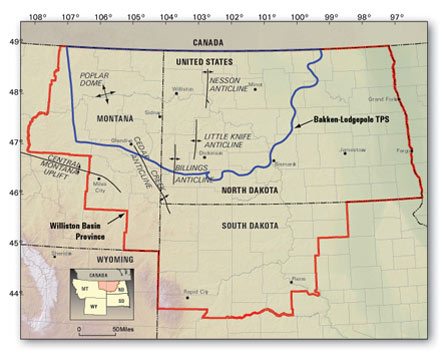|
NEWS NOTES
Oil in the Great Plains
Move over Texas and Alaska — Montana and North Dakota may be the country’s newest oil hotspots. Two new large-scale assessments have found that a 360-million-year-old rock layer located three kilometers below the rolling plains of eastern Montana and western North Dakota — called the Bakken Formation — holds between 3 billion and 4 billion barrels of recoverable oil. That makes the Bakken one of the largest oil reservoirs in the lower 48 states, geologists say. Now the question is: How much of that oil is economically attractive to produce?
 U.S. Geological Survey |
| The Williston Basin is outlined in red and the Bakken Formation in blue. |
The Bakken Formation is located within the Williston Basin, which stretches from the southern portion of the Canadian provinces of Saskatchewan and Manitoba into parts of Montana, North Dakota and South Dakota. The Bakken is an “unconventional” oil resource. Instead of its oil collecting in large, discrete pools, much of it is “continuous,” or spread widely throughout the formation and trapped by shale. Using the area’s geology and historical oil production records, U.S. Geological Survey (USGS) geologists created a geologic model to estimate the American portion of the Bakken. According to their assessment, released April 10, it contains a mean volume of 3.65 billion barrels of undiscovered oil that is recoverable using today’s technology.
That number is 25 times larger than what USGS estimated in its last assessment of the Bakken in 1995. The difference is largely due to both advances in technology that allow for greater oil extraction and a better understanding of the area’s geology, says Richard Pollastro, a USGS geologist based in Denver, Colo., who led the assessment.
The USGS work is backed by the North Dakota Department of Mineral Resources, which announced on April 28 the results of its own assessment of the part of the Bakken in North Dakota. It estimated the total amount of oil within that portion is 168.8 billion barrels, but at the moment only 2.1 billion barrels are considered technically recoverable (compared to the average of 2.6 billion barrels that USGS estimates is in North Dakota’s share of the Bakken).
“Each study validates the other,” says North Dakota’s State Geologist Ed Murphy. “For companies that have been on the fence, this is certainly positive news,” he says. “For companies that are already here … this probably validates what they’ve seen.”
For the 15 to 30 companies in North Dakota that operate wells in the Bakken, the results are unlikely to affect their business plans, says Ron Ness, president of the North Dakota Petroleum Council, an oil and gas trade association in Bismarck. Most of the Bakken’s resources are already privately owned, Ness says, and it is still not yet clear how much of the oil is recoverable from an economic standpoint. That’s because producing oil from unconventional resources like the Bakken is more difficult and thus more costly, Pollastro says. “To drill up this resource,” he says, “it’s going to take at least 25,000 to 30,000 wells.”
But improvements in technology and the rising price of oil have made developing these resources much more appealing. “It’s the fastest-growing type of resource in the United States,” says Brenda Pierce, program coordinator of the USGS Energy Resources Program in Reston, Va. In fact, 105 million barrels of oil have been recovered from the Bakken since oil was first discovered there in 1951. Most of that oil has been produced at the Elm Coulee oilfield in eastern Montana. Discovered in 2000, Elm Coulee now ranks as the country’s 25th-largest oilfield in terms of proven reserves, according to the U.S. Energy Information Administration.
USGS will provide further details on oil in the region this fall, when it completes its oil assessment of the larger Williston Basin. Ultimately, only the companies themselves can determine how much of the Bakken’s oil is economically recoverable, Ness says. However, he adds, the new assessments “may attract additional interest” in the area.

 Subscribe
Subscribe


